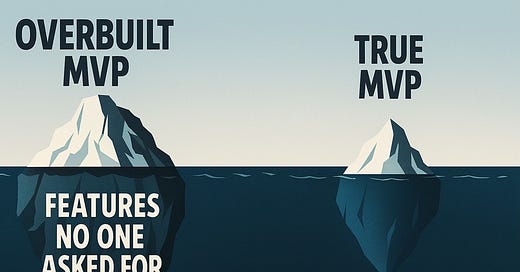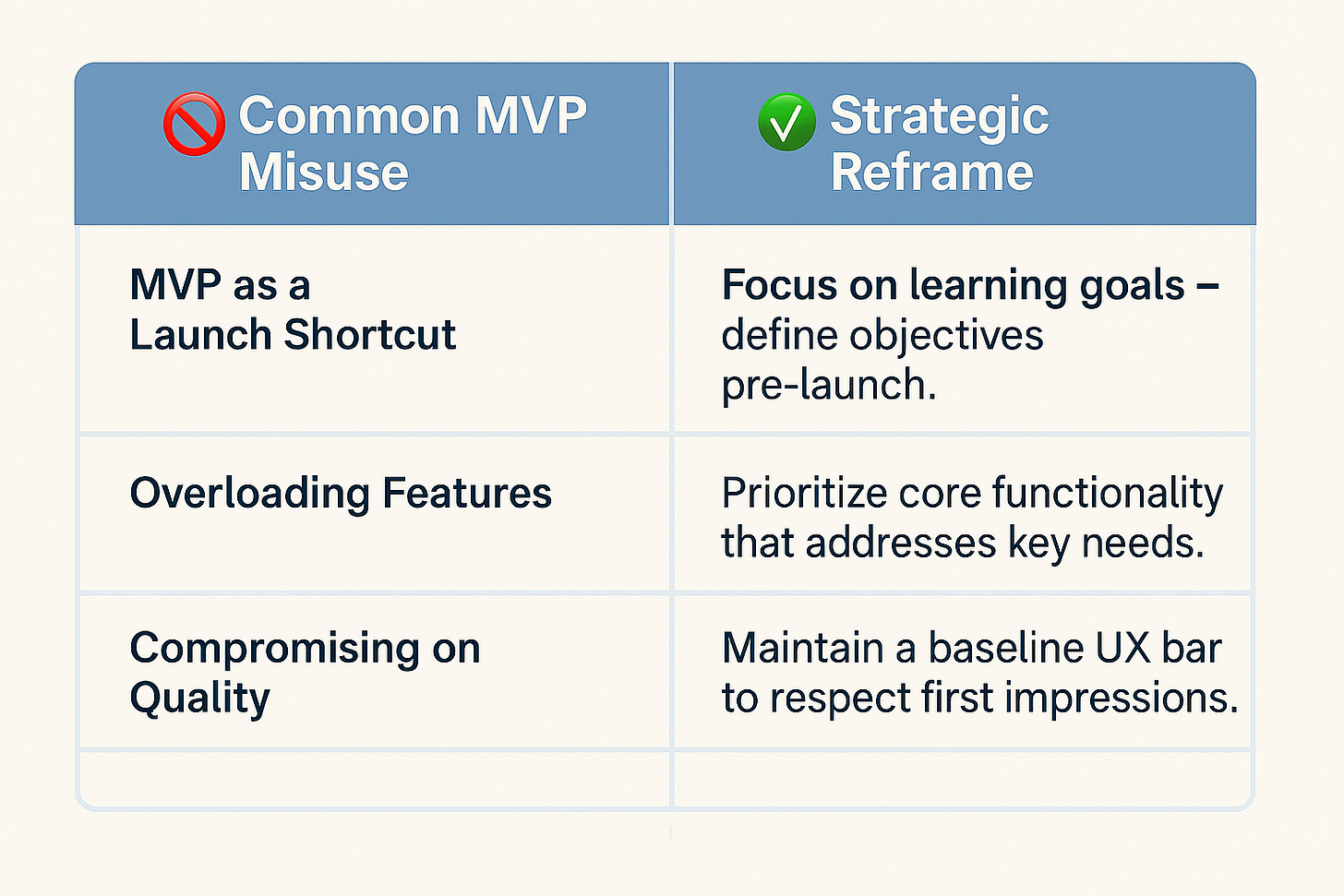The Myth of the MVP: What “Minimum Viable” Really Means
How to Build Less, Learn More, and Reduce Risk Early
🎧 Now a Podcast Conversation
This article inspired a new episode of The Product Leader’s Playbook, where our AI hosts break down the MVP myth and explore why less can actually lead to more.
How MVPs get misused as shortcuts, feature dumps, or excuses for low quality
What a true MVP looks like, and how to build one
Reframes, real examples, and practical takeaways you can use with your team
→ 🎙 Listen on Spotify | Listen on Apple Podcasts
🚨 “Let’s Just Launch the MVP…”
It sounds agile. It sounds lean.
It’s also one of the most misunderstood phrases in product.
For some teams, MVP means the fastest thing they can ship.
For others, it’s a full-blown V1 camouflaged by buzzwords.
👉 It’s time to reframe MVP for what it was meant to be:
a strategic learning tool, not a lean-looking launch plan.
❌ Where MVPs Go Off the Rails
Too often, MVPs are misapplied in three costly ways:
1. MVP as a Launch Shortcut
“Ship it fast and see what happens.”
But without a clear learning goal, you’re not being lean, you’re just guessing faster.
2. MVP with Too Many Features
To appease stakeholders, we sneak in “just one more thing.”
The result? Bloated MVPs that delay feedback and dilute learning.
3. MVP as an Excuse for Low Quality
“Don’t worry, it’s just the MVP.”
That mindset leads to broken experiences.
Customers don’t care what phase you’re in. Their first impression is your product.
✅ What MVP Actually Means
A real MVP is the smallest thing you can build to validate a key assumption.
Minimum = What’s the lightest slice of value you can test?
Viable = Will it produce meaningful feedback?
It’s not about shipping fast.
It’s about learning with intention and reducing uncertainty.
🔍 Real-World MVP: Testing AI Transcription
While leading the development of an AI transcription tool for editorial teams, the full roadmap was ambitious. But the MVP? Deliberately raw:
Simple file upload
Limited formats
Minimal formatting, no UX polish
Just raw AI output
The learning goal: Can AI transcripts meet our editorial accuracy threshold?
We quietly rolled it out to a small group of editors and collected feedback over a few weeks.
That feedback shaped everything - UI priorities, model tuning, and where human intervention was still needed.
💡 By resisting the urge to overbuild, we earned faster insight, and the trust to invest in what mattered next.
🧠 A Better Way to Build MVPs
If you want to build a real MVP, start here:
Identify the riskiest assumption.
What could kill the product if you’re wrong?Define a clear learning goal.
What do you need to learn, and how will you measure it?Don’t assume you need to launch.
Some of the best MVPs never touch production - think prototypes, concierge flows, or user interviews.Design for insight, not scale.
You're optimizing for direction, not metrics.Make it lovable where it counts.
Even a scrappy test should show users you respect their time.
🗣️ MVP Misconceptions from Stakeholders (And How to Reframe Them)
“Can we add just one more thing?”
→ “Let’s test the core assumption first. We’ll save that for the next iteration.”“Let’s polish it a bit more before we ship.”
→ “Polish isn’t what we need right now. Insight is.”
These simple reframes can help PMs align teams without diluting the MVP’s purpose.
This framework helps teams avoid the three most common MVP pitfalls—and shift the focus from speed to strategic clarity.
📋 MVP Assessment Checklist
Use this quick self-check before declaring something your MVP:
Identify the Core Problem:
Is the MVP addressing a well-defined user problem?
Define Success Metrics:
What KPIs will determine the MVP's success?
Ensure Minimal Feature Set:
Are you testing the lightest slice of value?
Plan for Iterative Feedback:
Is there a process to collect and apply feedback?
Maintain Quality Standards:
Does the MVP reflect respect for the user experience?
💬 Final Takeaway
“Minimum” doesn’t mean careless.
“Viable” doesn’t mean valuable.
A real MVP is:
Purposeful
Targeted
Humble
It’s not a shortcut to launch.
It’s a strategic bet, a way to reduce uncertainty and focus your team on what matters.
Because great products don’t start with perfection.
They start with insight, and the courage to test it.
🔄 Your Turn
What’s the worst misuse of MVP you’ve seen?
How do you define MVP on your team?
Drop your thoughts in the comments, or forward this to someone still treating MVP like a shipping tactic.
🎧 Want to Go Deeper?
This article is also available as a podcast episode on:
🎙 The Product Leader’s Playbook is streaming everywhere:
🔹 Spotify
🔹 Apple Podcasts
🔹 YouTube | Amazon Music





